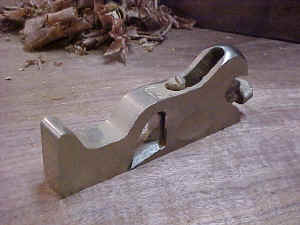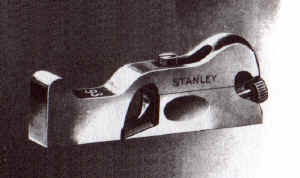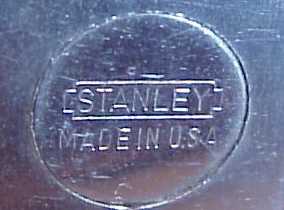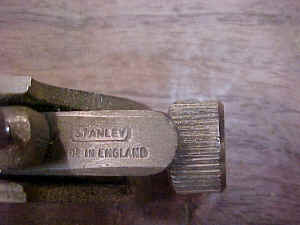
Stanley #92 Cabinet makers Plane (later type made in England) 5

1909 Catalog Image of Stanley No 93 Cabinet Makers
Rabbet Plane2

Disc on Nose Piece with Later Notched Trademark6

Stanley No 92 Blade Trademark for Later English Type
|
|
Features1: Adjustable
Throat
Manufactured1: 1902 to 1969
Patents1: Traut's 3/13/1900 (endwise
screw cutter
adjustment)
Dimensions1: 5-1/2 inches long
Cutter1: 1 inch wide
Construction1: Cast Iron
Finish1: Nickel plated
User Info1: An extremely accurate adjustable throat
rabbet plane used by cabinetmakers for fine, close tolerance work either vertically or on
its right or left side. The top front portion of the plane can be moved back and forth to
control thickness of the shaving. Another standard tool in a fine workshop.
Average Price1: $75 to $150
Type 11: $100 to $200
Current English Production Prices:
Garret-Wade8 : $77.70 (Blade $11.50)
Woodcraft9: $79.99 (Blade $11.00)
Note1: A steel disc was inserted onto the front of
the plane. This disc covers the hole for the sand core that made the front portion of the
plane hollow. On most types, the trademark will be stamped on this disc which can be used
to determine vintage. Type 1 does not have the disc. The bottom of the plane is a
separate
piece pinned to the sides which allowed casting the front portion of the plane with a
hollow cavity to reduce weight. Always check the cutter on the later types to avoid buying
an English model. English models made after 1980 are not hollow and do not have the disc.
Tuning7: Garret Hack notes that "The key to
tuning any rabbet plane is aligning the iron both with the sole and with the side (or
sides) of the plane. The object is to have the cutting edge parallel with the sole and
parallel with, and just barely peeking out, on the side.This is one of those things that
is easier said than done, and will take some experimenting.
Once the iron is aligned with the side, check that it's parallel
with the sole. The only way to remedy any large misalignment is by grinding and rehoning
the edge. With the iron properly ground and honed, careful honing in the future should
keep everything in alignment"
Sources:
1. Walter, John . "Antique & Collectable Stanley Tools, Guide
to Identity and Value", 2nd Edition, 1996
2. Wood, Jack P. "Early 20th Century Stanley Tools, Price Guide". Contains
reprints of the 1909 and 1926 Stanley Works Tool Catalogs.
3. Smith, Roger K., Reprint of Stanley Catalog No 120 orginally issued in 1923,
"Carpenters' and Mechanics Tools", The Stanley Rule and & Level Plant, The
Stanley Works, New Britain, Conn., U.S.A.
4. Lee, Leonard, "The Complete Guide to Sharpening",Taunton Press, Inc.,1995
5. Stanley No 92, Later Type made in England, Tool Collection of Gordon Muster . New
Condition. Nickel is 100%. Purchased December 1998 at Woodcraft for about $75
6. Example found on Ebay
7. Hack, Garret, "Rabbet Planes Are Real Shop Workhorses", Fine Woodworking,
Jan/Feb 1998.
8. The Garret-Wade Tool Catalog, Number 7, Volume #26, November 1999
9. Woodcraft Catalog, September 2000 Catalog |